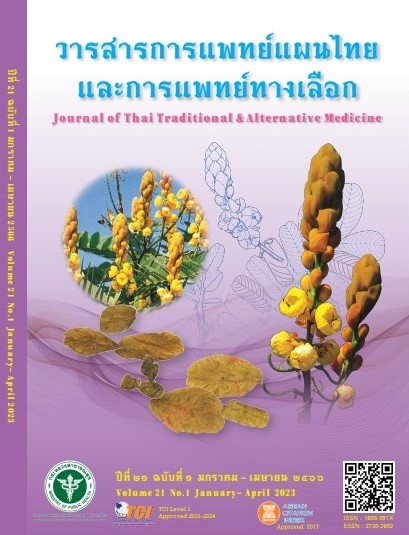Screening for Determination of Immunomodulatory Activities of Medicinal Plants Using Lymphocyte Proliferation Assay Detecting Immunomodulating Activities of Medicinal Plant
Main Article Content
Abstract
The objective of this study was to screen Thai medicinal plant extracts for lymphoproliferative activities in peripheral blood mononuclear cells. Seventeen medicinal plant extracts were tested for lymphocyte proliferation
in vitro assay, using the carboxyfluorescein succinimidyl ester (CFSE) for intracellular labelling of lymphocytes and tracking the cell proliferation with the flow cytometer. The proliferative cells were detected by progressive reduction in CFSE fluorescence intensity. It was found that water extracts of Helicteres isora L., Mesosphaerum suaveolens (L.) Kuntze, could stimulate the lymphocyte proliferation, while Kaempferia parviflora Wallich ex Baker inhibited lymphocyte proliferation in vitro. The screening tool for detecting immunomodulating activities of Thai medicinal plants could identify the properties of extracts that lead to the development of Thai traditional medicines to further promote treatment and stimulate immunity with Thai herbs.
Article Details

This work is licensed under a Creative Commons Attribution-NonCommercial-NoDerivatives 4.0 International License.
References
Technical and Planting Division. Technical and knowledge bank working group [Internet]. [cited 2022 Oct 15]. Available from: https://tpd.dtam.moph.go.th/index.php/ news-ak/technical-manual-ak/554-herbresearch
Lyons AB, Hasbold J, Hodgkin PD. Flow cytometric analysis of cell division history using dilution of carboxyfluorescein diacetate succinimidyl ester, a stably integrated fluorescent probe. Methods Cell Biol. 2001;63:375-98.
Böyum A. Separation of leukocytes from blood and bone marrow. Introduction. Scandinavian journal of clinical and laboratory investigation. Supplementum 1968;97:7.
The plant list. Malvaceae [Internet]. 2013 [cited 2020 August 28]. Available from: http://www.theplantlist.org/tpl1.1/search?q=helicteres+isora
Santisuk T, Larsen K. Flora of Thailand: Volume 7 Part3 Alismataceae Aponogetonaceae Ctenolophonaceae Cymodoceaceae Hamamelidaceae Hydrochartitaceae Lemnaceae Limnochartitaceae Melastomataceae Polygalaceae Potamogetonaceae Sterculiaceae. Bangkok: Royal Forest Dept; 2001.
Tang Y, Gilbert MG, Dorr LJ. Helicteres. In Flora of China Vol. 12. 2007. p. 318.
Kumar N, Kumar SA. Plant profile, phytochemistry and pharmacology of Avartani (Helicteres isora Linn.): A review. Asian Pac Journal of Tropical Biomedicine. 2014;4(Suppl1):22-6.
Radapong S, Sahad T, Harnkit N, Suppajariyawat P, Akkpaiboon Okada P, Meechalad W, Sincharoenpokai P, Niumsakul S, Buaboa S, Ontong S, J. Ritchie K, Chaisomboonpan S. Anti-SARS-CoV-2 activity screening of the selected Thai medicinal plants and potential hosttarget molecules. Bulletin of the Department of Medical Sciences. 2022;64(2):93-105.
Boopathy Raja A, Elanchezhiyan C, Sethupathy S. Antihyperlipidemic activity of Helicteres isora fruit extract on streptozotocin induced diabetic male wistar rats. European Review for Medicine Pharmacological Sciences. 2010;14:191-6.
Venkatesh S, Madhava Reddy B, Dayanand Reddy G, Mullangi R, Lakshman M. Antihyperglycemic and hypolipidemic effects of Helicteres isora roots in alloxaninduced diabetic rats: A possible mechanism of action. Journal of Natural Medicines. 2010;64(3):295-304.
Gupta RN, Pareek A, Suthar M, Rathore GS, Basniwal PK, Jain D. Study of glucose uptake activity of Helicteres isora Linn. fruits in L-6 cell lines. International Journal of Diabetes in Developing Countries. 2009;29(4):170-3.
Suthar M, Rathore GS, Pareek A. Antioxidant and antidiabetic activity of Helicteres isora (L.) fruits. Indian Journal of Pharmaceutical Sciences. 2009;71(6):695-9.
Suppajariyawat P, Aunkat S, Sudhong W, Buabao S, Sincharoenpokai P. Investigation of mutagenic activity of Helicteres isora L. extract. Journal of Thai Trad Alt Med. 2020;18(3):548-59. (in Thai)
Almeida-Bezerra JW, Rodrigues FC, Lima Bezerra JJ, Vieira Pinheiro AA, Almeida de Menezes S, Tavares AB, Costa AR, Augusta de Sousa Fernandes P, Bezerra da Silva V, Martins da Costa JG, Pereira da Cruz R. Traditional uses, phytochemistry, and bioactivities of
Mesosphaerum suaveolens (L.) Kuntze. Evidence-Based Complementary and Alternative Medicine. 2022 Mar 10;2022
Smitinand T. Thai plant names. 2nd ed. Bangkok: Royal Forest Department; 2001. 810 p. (in Thai)
Faculty of Pharmacy Ubonratchathani University. Labiatae [Internet]. [cited 2022 Oct 15]. Available from: http://www.phargarden.com/main.php?action=viewpage&pid=268 (in Thai)
Mishra P, Sohrab S, Mishra SK. A review on the phytochemical and pharmacological properties of Hyptis suaveolens (L.) poit. Future Journal of Pharmaceutical Sciences. 2021;7(1):65.
Kunkongkapan S, Sriwantana B, Chavalittumrong P, Warachit P. Efficacy and safety of Hyptis suaveolens extract in HIV-infected individuals: A preliminary study. Journal of Lanna Public Health. 2007;3(3):255-62. (in Thai)
Sapcharoen P. Medicinal plants in Thailand. 1st ed. Nonthaburi: Thai Traditional Medicine Development Foundation; 2006. 464 p. (in Thai)
Sookkongwaree K, Geitmann M, Roengsumran S, Petsom A, Danielson UH. Inhibition of viral proteases by Zingiberaceae extracts and flavones isolated from Kaempferia parviflora. Pharmazie. 2006;61(8):717-21.
Sornpet B, Potha T, Tragoolpua Y, Pringproa K. Antiviral activity of five Asian medicinal pant crude extracts against highly pathogenic H5N1 avian influenza virus. Asian Pacific Journal of Tropical Medicine. 2017;10(9):871-6. 22. Yenjai C, Prasanphen K, Daodee S, Wongpanich V, Kittakoop P. Bioactive flavonoids from Kaempferia parviflora. Fitoterapia. 2004;75(1):89-92.
Banjerdpongchai R, Chanwikruy Y, Rattanapanone V, Sripanidkulchai B. Induction of apoptosis in the human Leukemic U937 cell line by Kaempferia parviflora Wall. ex.Baker extract and effects of paclitaxel and camptothecin. Asian Pacific Journal of Cancer Prevention. 2009;10(6):1137-40.
Potikanond S, Sookkhee S, Na Takuathung M, Mungkornasawakul P, Wikan N, Smith DR, Nimlamool W. Kaempferia parviflora Extract exhibits anti-cancer activity against HeLa cervical cancer cells. Front Pharmacol. 2017;8:630.


